Abstract
In order to limit various alien species by ballast water, electrolysis of ballast water is used to sterilize microorganisms. In this process, total residual oxidizer (TRO) is produced, and it is necessary to measure the precise TRO concentration to prevent excessive disinfection by-products and limit emissions. In this TRO concentration measurement system, a white LED module and RGB sensor are used to measure the absorbance through the DPD colorimetric method. The intensity of LED light has a little error for each LED module. In addition, the effect of LED aging in which the intensity of the light source decreases with the elapsed time. For this reason, the TRO concentration measurement error increases. To solve this problem, we propose an LED module calibration algorithm by current PI control and an optimal LED operation time derivation to reduce the effect of LED aging. A large number of LED modules were applied to various seawater environments. In the conventional method, the measurement accuracy and precision of the average TRO concentration were 6.56% and 9.54%, respectively, and measurement accuracy and precision through the proposed algorithm and LED aging optimization were greatly reduced to 0.10% and 0.85%, respectively. In addition, we derived that LED aging was minimized when the measurement time of LED light was 1 s and the turn-off time of the LED light was 10 s. Through these experimental results, we confirmed that the non-uniform LED light is improved by the proposed algorithm. Furthermore, the standard values for TRO concentration measurement (accuracy: less than 5%, precision: less than 2%) were satisfied.
1. Introduction
We know that the influx of alien species caused by the movement of ballast water to balance ships with the increase of international trade causes serious problems in the marine ecosystem [1,2]. For this reason, in 2004, the International Maritime Organization (IMO) adopted the “Convention on the Control and Management of Ballast Water and Sediment Emissions” [3]. As a result, the 2019 Convention took effect and, in the future, all ships are required to install a Ballast Water Management System (BWMS) to sterilize the ballast water and meet the emission standards [4].
The main sterilization processes of BWMS include electrolysis, the input of active substances such as ozone, UV irradiation, and heat treatment [5,6,7]. The electrolysis of water is the most widely used because of its cost and effectiveness [8]. Electrolysis of ballast water produces Total Residual Oxidant (TRO) capable of sterilizing microorganisms [9,10]. The electrolysis method BWMS must control the current to generate an appropriate TRO to prevent sterilization and excessive disinfection by-products in accordance with IMO D-2 regulations. For this reason, it is important to measure the correct TRO concentration.
Depending on the method of measuring TRO, there are DPD (N, N-Diehyl-p-phenylene diamine) colorimetric, ULR-DPD colorimetric, DPD titration, the iodometric method, the amperometric method, and the electrode method [11,12]. Among them, the DPD colorimetric method is the most effective method in ballast water treatment equipment, and the DPD reagent reacts with the residual oxidant dissolved in water to form an oxide (Würster Dye) and develops a magenta color. At this time, the color factor of the oxide is absorbed at the wavelength of 510~520 nm, and the absorbance value is derived in proportion to the TRO concentration [13]. The TRO concentration measurement system must satisfy the accuracy of less than 5% and the precision of less than 2%, which are included in the standards for type approval and quality inspection of environmental measuring devices in seawater conditions [14].
A high-brightness LED and RGB sensor are used in the TRO concentration measurement system. The high-brightness LED emits white light, and the RGB sensor can measure the intensity of the light source by separating the red, blue, and green light sources [15,16,17]. In this way, if the green and blue wavelengths are used among these types of wavelengths, it is possible to measure the TRO concentration with more than double accuracy even at high concentration (over 10 mg/L) [18,19]. However, in these semiconductor devices, an output error of the light source and a sensing error of the RGB sensor were made due to the manufacturing process, durability, and environmental factors [20]. This error reduces the measurement accuracy of the TRO concentration. Therefore, precise correction of the light source and RGB sensor is required for accurate TRO concentration measurement. In addition, in the LED light, the intensity of the light source decreases in inverse proportion to the turn-on time, which is called LED aging [21,22,23]. The most representative cause of LED aging is the internal LED temperature [24]. As the internal temperature of the LED increases, the intensity of the light source decreases and reaches a constant output after a long period of time [25]. Conversely, when the LED light is turned off, the intensity of the light source gradually recovers over time. However, the DPD reagent used to measure the TRO concentration variation color over time causes low measuring accuracy [26]. For this reason, it is necessary to minimize the turn on/off time of the LED light and to derive the optimal sensing point.
In this paper, we propose a new calibration strategy for LED modules to improve the measurement accuracy of TRO concentration. Through the proposed controller and algorithm, the measurement accuracy for TRO concentration can be greatly improved. We conducted these experiments in various seawater environments with the manufactured TRO concentration measurement system. The conventional TRO concentration measurement method and problems are reviewed in Section 2. The strategies to improve measurement accuracy for TRO concentration are presented in Section 3. Section 4 presents the experimental setup. Section 5 presents the experimental results and discussion. Finally, the conclusion is given in Section 6.
2. Conventional TRO Concentration Measurement Method and Problems
The conventional TRO concentration measurement sequence based on the DPD colorimetric method is shown in Figure 1.

Figure 1.
TRO concentration measurement process using DPD colorimetric.
Firstly, the white LED light is primarily turned on in the sample solution while blocking the light coming from the outside. The maximum current applied to the white LED light is 30 mA and at this time it has 7000 mlm. The light source passing through the sample solution can obtain the intensity of light for each red, green, and blue wavelength region through the RGB sensor. The RGB sensor is a semiconductor device that converts light energy into electrical energy. As the intensity of light increases, a higher frequency is generated and it is output in the form of a square wave with a 50% duty rate. To increase the resolution of TRO concentration measurement, the output frequency of the green wavelength region (510–520 nm) and blue wavelength region (460-480 nm) is measured. Thereafter, adding the DPD reagent to the sample solution, the white LED light is lit once again. In the same way, we record the output frequencies of the green and blue wavelength region. The absorbance is calculated by substituting the two types of output frequencies measured in the 1st and 2nd order to the Beer’s Lambert law and is shown in Equation (1). This law states that the negative logarithm of the ratio of the intensity of light incident on a material () and the intensity of transmitted light () is proportional to the absorbance of the transmission layer.
where is the absorbance, is the extinction coefficient, is the thickness of the transmission layer, and is the concentration of the solution. The Beer’s Lambert law can be used to determine the absorbance of a sample and compare it with a reference absorbance to derive the concentration. Equation (2) shows the process of calculating the TRO concentration through the absorbance.
where is the reference of TRO concentration. The TRO concentration for each absorbance is calculated. Even if such TRO concentration measurement is repeatedly performed, a constant value must be calculated, and the outputs of a plurality of LED light and RGB sensors must be constant. However, each LED light and RGB sensor do not all have the same output, but have a slight error. This causes an error in absorbance. Figure 2 shows the frequency output from a single RGB sensor when a constant current is applied to various LED light.
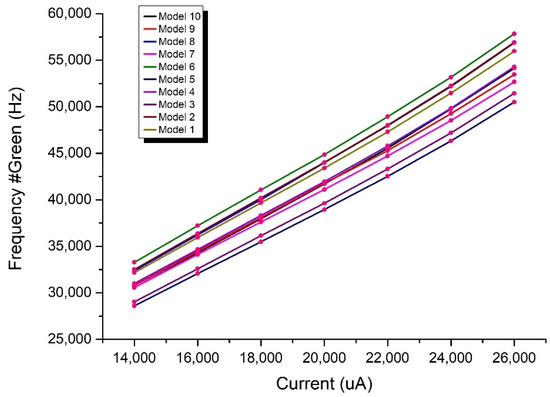
Figure 2.
RGB sensor output frequency (green) according to LED light intensity.
It can be seen that there is a difference in the output frequency even though the LED light is the same product. One of these can cause a slight error in the output spectrum due to the current bias passing through the inside of the LED light. In addition, the performance change of the LED light due to manufacturing defects, irregular light source output according to the roughness of the surface of the reflector, fine unevenness and irregular shape of the lens surface may change the output of the light source. In order to solve these manufacturing problems, a lot of time and cost are required. Therefore, careful calibration is required for each LED light and RGB sensor to increase the TRO concentration measurement accuracy. The calibration process is often performed only once at the time of shipment from the factory. In this case, LED aging occurs due to the repeated ON and OFF of the LED light, and the output of the LED light is reduced even when the same current is applied. This increases the serious errors for absorbance and TRO concentration.
3. Strategies to Improve Measurement Accuracy for TRO Concentration
In the case of an LED light, if there is a difference in output even when the same current is applied, our unique calibration method is possible by adjusting the intensity of the applied current. Through this, the absorbance and TRO concentration error for the LED light are reduced. In addition, if an LED light that exceeds the error range or outside of the calibration range is identified, it can be selected. In the case of an RGB sensor, the measuring difference which occurred was caused by the frequency values received from a large number of light sensors for the same intensity of light output from a reference LED light. This difference can be calibrated by adding a compensation coefficient for the corresponding frequency. As such, the selection process and calibration process for spectrophotometry are precise processes of repeatedly confirming reference parameters and measured values, and thus we had to do those manually. Due to the disadvantage, it takes a long time to perform the selection and calibration process only by hand, and there are practical difficulties in mass production and mass production.
To compensate for these shortcomings, the quick calibrating algorithm and the selecting LED light are needed. The calibration and selection algorithm are not performed only once in the initial stage, but is performed every TRO concentration measurement. Through this, we can measure and calculate the correct absorbance and TRO concentration.
The conventional measurement method is just measuring the frequency by applying a fixed current. This method is suitable for ideal water environment. However, commonly used solutions often contain impurities. In this case, it is impossible to obtain the accurate frequency value in the case of the conventional method. Therefore, an appropriate calibration algorithm is required. In this paper, we propose the accurate and quick frequency measuring algorithm by performing the proper and precise calibration and selection at the same time.
Figure 3 shows the proposed control algorithm that divides into Mode 1 and Mode 2. In the case of Mode 1, it consists of a PI controller and limiter. The frequency is measured by the RGB sensor. The reference frequency is 30,000 Hz, and it is controlled by the reference frequency and the measured frequency. When the output frequency reaches 30,000 Hz through Mode 1 operation, the aging compensator works. The output of the LED is maintained in a normal state through the aging compensator. Mode 2 operation operates based on the current value when the output frequency is 30,000 Hz. It is composed of a PI controller and limiter and can follow the reference output current.
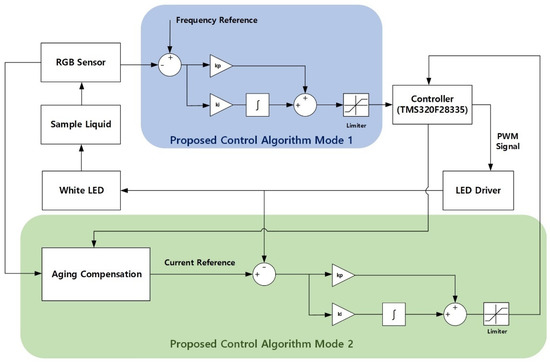
Figure 3.
Proposed Control Algorithm for LED module calibration.
3.1. LED Module Calibration Algorithm
Figure 4 shows the flow chart of the proposed control algorithm. The flow chart is divided into Mode 1 and Mode 2. When the algorithm starts, it measures the current and frequency. The PI controller operates through the value of the frequency and operates until the value of the reference frequency and the value of the output frequency are the same. If the reference frequency is matched, the output current value is saved as the reference current. If the reference current is determined, Mode 2 operates, and Mode 2 follows the reference current value through the PI controller. The reference current follows the value and, after operation, the output of the LED is maintained in a normal state through aging compensation. It operates until the output current matches the reference current, and when the output current and the reference current are just the same, the algorithm operates.

Figure 4.
Mode switching algorithm for LED module calibration.
The correction data derived through the proposed algorithm can increase the accuracy of TRO concentration measurement. Figure 5 shows the TRO concentration measurement sequence after applying the proposed algorithm. First, select the reference LED module and RGB sensor whose output green frequency of LED light becomes 30,000 Hz for the input current value.
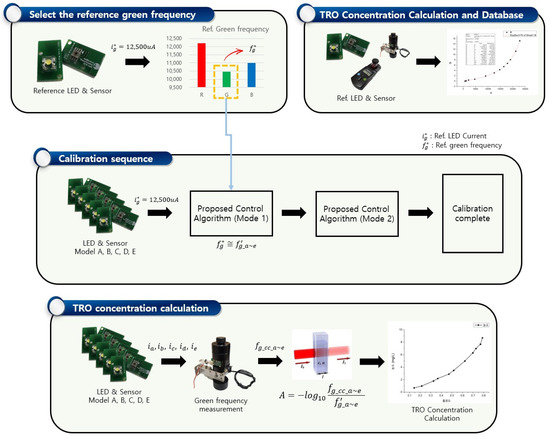
Figure 5.
Operation sequence for calibrating LED module and calculating TRO concentration.
Using this model, we collect TRO concentration data according to absorbance. These data are used as reference values when finally measuring the concentration. For the uncalibrated LED module, the sample solution is irradiated with LED light. If an error occurs in the output green frequency, the optimal output current value is found through the proposed algorithm. This process is carried out in Mode 1. Then, the second LED light is irradiated with the output current value optimized for the sample solution mixed with the DPD reagent. Accordingly, it is possible to calculate the absorbance of the sample solution and derive a precise TRO concentration.
3.2. LED Module Calibration SIMULATION with Simulink
The LED light intensity is based on the reference light source. In order to emit the same light intensity of each light source, a calibration process is performed by adjusting the current value of the LED. The proposed algorithm suggests current calibration through the PI controller. The control process was verified through Simulink. Figure 6 shows the proposed algorithm and also simulates the control algorithm by using Simulink. The basic configuration consists of a PI controller, limiter, reference frequency, and TRO sensor. In the case of this system for mass production, the Kp and Ki gain values were selected through tuning during the manufacturing process. In the case of the TRO LED sensor, the ratio of brightness is slightly different depending on the current, depending on each sensor. Therefore, in this paper, accurate current can be calculated by applying the PI controller.
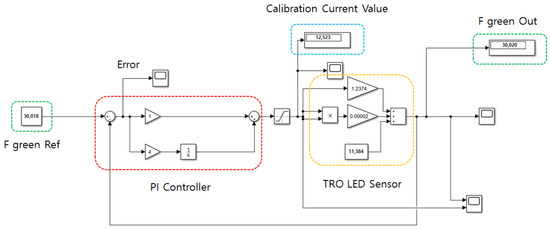
Figure 6.
Proposed control algorithm for LED module calibration.
Refer to Figure 6, it shows the Simulink simulation. The main indicators of the graph are composed of error, reference value and output value, and current value (for control). Figure 7a is the difference between the reference green frequency and the output green frequency, that is, the error. Although an error occurs initially, it can be seen that the error converges to zero by the PI controller. Figure 7b is the graph comparing the reference green frequency and the output frequency. Refering to the graph, it can be seen that the value of the initial green is different from the standard. It can be confirmed that the correction algorithm converges to the reference value. Figure 7c is the calibrated current value, and the brightness of the light source can be adjusted by the current value. Therefore, it can be seen that the output varies according to the current value, which is the control value, and converges to approximately 12,500 uA through the graph. In the case of the current value, different values are selected depending on the light source, but the output green frequency converges in the same way.
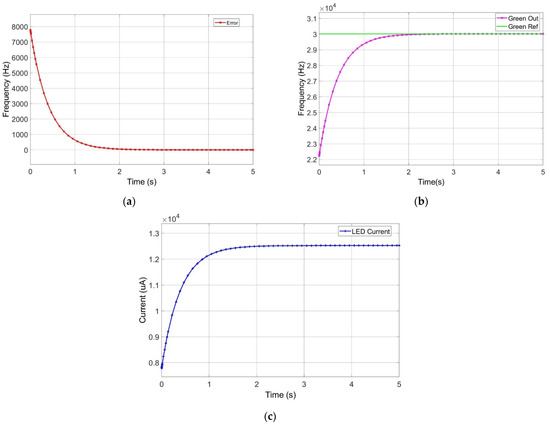
Figure 7.
Simulation waveforms of proposed control algorithm for LED module calibration: (a) green frequency reference and output value; (b) output current value; (c) error between reference and output green frequency.
The current and error value are selected depending on the light source, but the output green frequency converges in the same way.
3.3. The Solution about LED Aging Effect
In the case of an LED light for measuring TRO concentration, a constant light source must be output for absorbance measurement by spectrophotometry. For quick TRO concentration measurement, the intensity of the LED lights should be at a constant value regardless of the time from the first light emission to the end. However, when a constant current is applied to the actual LED light, the intensity output from the LED light decreases with time. This phenomenon is the same for green and blue light. This case is shown in Figure 8. When light is emitted and heats up, it affects both the life cycle and the luminous flux of the LED. Therefore, the longer the LED is turned on, the more severe the heat. The decreasing intensity of the LED light starts to output a constant value after around 50 s. However, it is not possible to wait until the LED light is stabilized for a long time of several tens of seconds or more when measuring the TRO concentration. The intensity of the light source should sustain the same output when the LED is turned on in the shortest possible time (1~3 s) and then turned on again after an OFF period of emptying and refilling the water. In other words, it is necessary to derive the optimized LED ON/OFF time so that the LED ON time is ON for 1~3 s while the OFF time is short.
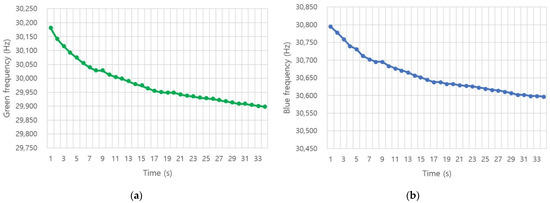
Figure 8.
Decreasing in intensity of LED light over time due to LED aging: (a) green light output frequency; (b) blue light output frequency.
When the intensity of the LED light was measured when the LED was turned on for a long time, the value was lower than the reference value. In other words, the longer the LED is turned on, the more the green frequency value decreases. This is caused by a decrease in the LED light output due to an increase in the temperature inside the LED.
Since the intensity of the LED module decreases due to the influence of temperature, it is required to specify a section that can minimize the influence of temperature for accurate green frequency measurement. In addition, it is necessary to identify the time point at which the temperature of the LED module recovers until the next measurement after one measurement, and also consider the period.
As mentioned above, the ON time of the LED should be as short as possible and the OFF time of several seconds should be maintained. Accordingly, the ON time of the LED was set to about 1 to 3 s, and the optimum OFF time minimizes the green frequency error.
4. Experimental Setup
Figure 9 shows the experimental setup of the proposed TRO measurement system. The experimental environment consists of LED, sensor module, and LED driver. An oscilloscope and Code Compose Studio were used to measure the experimental data. The solution used for the experiment is injected through the device to which the sensor module and LED module are attached. Basically, the output of the sensor measures the frequency of the sensor through the light transmitted through the liquid from the LED. The frequency is measured through an oscilloscope and Code Compose Studio.
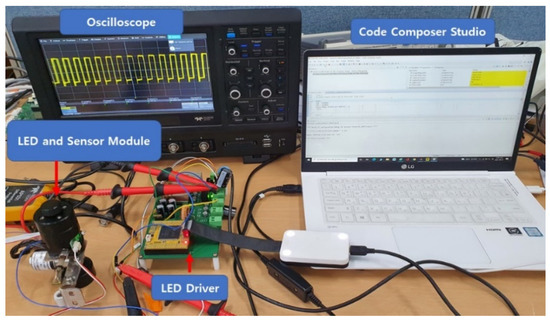
Figure 9.
Experimental setup of the proposed TRO measurement system.
Figure 10 shows the proposed calibration algorithm controller. The proposed controller consists of DC–DC converter, LED driver and DSP (TMS320F28335). The DC–DC converter is configured to supply power to the LED Driver and DSP. The algorithm operates by measuring the frequency and output current values measured through DSP. The control value of the algorithm is applied to the LED driver, and the light of the desired output can be transmitted through the solution and measured by the sensor.
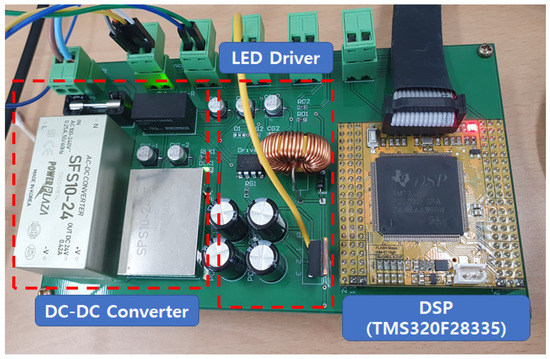
Figure 10.
Proposed calibration algorithm control board.
For the LED module, the OVFSW6C8 model with 4 Pin LED (7.6 mm) from Electronics is selected, and it is designed with a high forward voltage to maximize the brightness and efficiency of the light source together with a low-profile lens. In addition, the response characteristics are good and the power consumption is small. The radiation angle of the light source is 60°, and the beam has a maximum of 7000 mlm when a current of 30 mA flows through the LED module.
The applied RGB sensor is TAOS’s TCS3200 model, which outputs a specific frequency for each RGB light. The four types (colors) of photodiodes are interdigitated to minimize the effect of non-uniformity of incident irradiance. The TCS3200 programmable color light-to-frequency converters that combine configurable silicon photodiodes and a current-to-frequency converter on a single monolithic CMOS integrated circuit. The output is a square wave (50% duty cycle) with a frequency directly proportional to light intensity (irradiance). The nonlinear error is 0.2% at 50 kHz, and the temperature coefficient has a stable value of 200 ppm/°C. The response time of photodiode is normally under 0.1 µs. Table 1 shows the specifications of the LED module and RGB sensor.

Table 1.
Specification of LED module and RGB sensor used in TRO measurement system.
5. Results and Discussion
In order to increase the accuracy of the experiment, the number of LED module samples was set to 30. Figure 11 shows the variation of green frequency before and after calibration of LED modules and the current flowing through the calibrated LED module. It indicates that the intensity of light output from each LED light is different when the same current is passed. First, an initial set current (12,500 uA) is applied to each LED module. It can be seen that there is a large difference in the intensity of the LED light through the output green frequency.
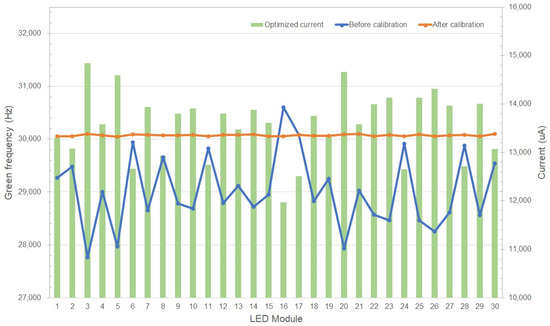
Figure 11.
Green frequency and current value before and after calibration of LED module.
In order to visually check the calibration algorithm for the LED module, the green frequency output from the RGB sensor was checked with an oscilloscope. Figure 12a shows the green frequency output of the LED module before calibration. LED module 1 displays a frequency close to the reference, while LED modules 2, 3, and 4 output a frequency lower than the reference frequency. Figure 12b shows the green frequency output that passed the Mode 1 process of the proposed algorithm. It can be seen that the LED modules, which had a low frequency, output a green frequency similar to the standard. As a result, it is considered that the performance of the proposed algorithm Mode 1 is greatly effective.
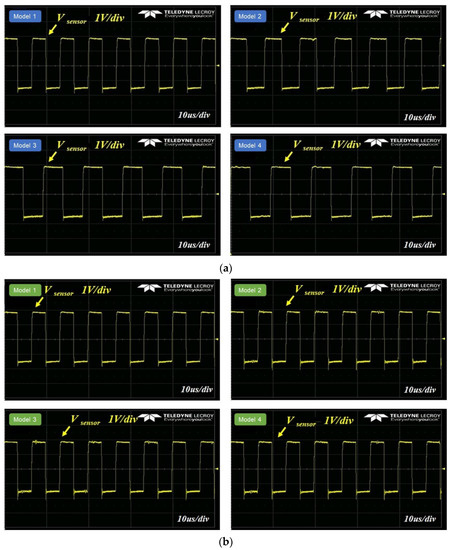
Figure 12.
Experimental waveform of green frequency from the RGB sensor: (a) LED modules before calibration; (b) LED modules after calibration.
In the case of the calibrated LED module, the output green frequency is almost constant, and it can be seen that the applied current is different accordingly. The procedure for calibrating the LED module corresponds to Mode 1. Additionally, the Mode 2 process was performed by adding DPD reagent. TRO concentration was measured at two points (1.4 mg/L, 3.7 mg/L). The green frequency was obtained by irradiating the secondary LED light, and the TRO concentration was derived by calculating the absorbance. Figure 13 shows the measured TRO concentration and the concentration error with respect to the reference value. It can be seen that the 30 LED modules used in the experiment have high accuracy close to the reference TRO concentration.
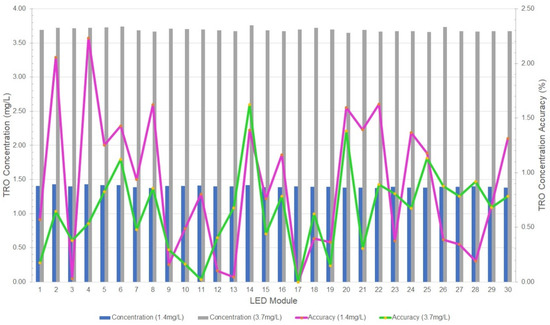
Figure 13.
TRO concentration and accuracy with the proposed algorithm.
The accuracy and precision were significantly improved compared with the conventional TRO concentration measurement through multiple LED module calibration. The results are shown in Table 2. The average measured green frequency was 29,021 Hz before correction and 30,073 Hz when the proposed algorithm was applied. It is closer to the standard 30,000 Hz. The maximum error of TRO concentration before correction was 31.9%, while the application of the proposed algorithm reduced the error of TRO concentration by 2.2%. The conventional DPD colorimetric method has 4% and 0.3% values for accuracy and precision, respectively. As a result of testing with 30 calibrated LED modules, the accuracy of the average TRO concentration was significantly improved from 6.56% to 0.86%, and the precision from 9.54% to 0.10%. This result satisfies the accuracy of TRO concentration within 5% and precision within 2%. The proposed algorithm has higher accuracy and precision compared to the conventional DPD colorimetric method and no calibration.

Table 2.
Measurement accuracy and precision result of TRO concentration applying the proposed algorithm.
The water environment, which is generally measured through the TRO concentration measuring device, does not always have a constant turbidity. Since the water quality environment in which this device will be used continuously should be able to measure from low turbidity to high turbidity, a TRO concentration measurement experiment was conducted in the range of 1~850 NTU turbidity. Figure 14 shows the experimental results for measuring TRO concentrations of 1 mg/L, 4.2 mg/L, and 8.1 mg/L with turbidity, respectively. When the proposed algorithm is not applied, the higher the turbidity, the lower the TRO concentration compared to the standard occurs. However, when the proposed algorithm is applied, the TRO concentration appears close to the reference value even if the turbidity increases. It was proven by the above experiments that the proposed algorithm can derive the correct TRO concentration without affecting the turbidity. Detailed data collected in the experiment are referenced in Appendix A. The measured average accuracies at low, medium, and high TRO concentrations according to turbidity are 1.97%, 1.62%, and 1.23%, respectively. We demonstrate and prove that the precise TRO concentration was measured by our proposed algorithm in various turbidity environments and TRO concentration range.
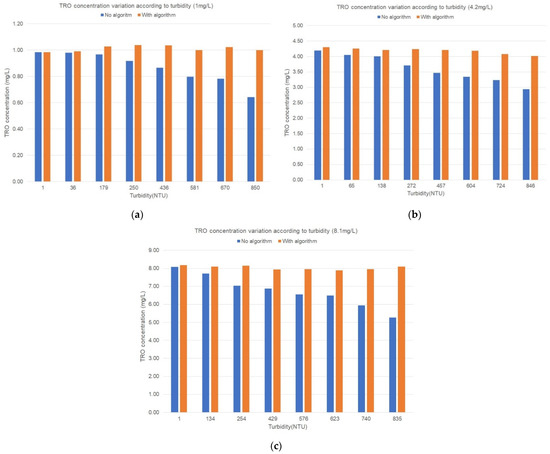
Figure 14.
TRO concentration with or without algorithm according to variation in turbidity: (a) 1 mg/L; (b) 4.2 mg/L; (c) 8.1 mg/L.
In order to solve the problem of reducing green frequency output due to LED aging, the optimal LED module ON and OFF times were derived. First, turn on the LED for calibration of the LED module, and secondly turn on the LED to measure the TRO concentration. The time to turn on the LED was set for 1, 2, and 3 s, and the time to turn off was set to 0, 3, 5, and 10 s. The obtained results are shown in Table 3. By comparing with each variation rate, we know that at the LED ON time of 1 s and the OFF time of 10 s, the variation rate is the lowest compared with the initial green frequency value. If this operating time is exceeded, some errors may appear in the TRO concentration measurement process. Therefore, for optimal TRO concentration measurement, it is desirable to maintain the turn on time of the LED module for 1 s and the turn off time for 10 s.

Table 3.
Green frequency variation rate according to LED module ON and OFF time.
6. Conclusions
In this paper, we propose an LED module calibration strategy to improve the measurement accuracy of TRO concentration. The algorithm for controlling the LED current (Mode 1) is primarily operated to calibrate a number of LED modules, and the LED current is controlled by the algorithm (Mode 2) for measuring the TRO concentration. As a result, the TRO accuracy before performing the algorithm was 6.56% and the precision rate was 9.54%, but after applying the algorithm, it improved to 0.85% and 0.10%, respectively. In addition, the optimal LED turn-on time and turn-off time were determined to improve LED aging. An optimal operation sequence could be designed at the turn-on time of 1 s and the turn-off time of 10 s. As a result of measuring TRO at low, medium, and high concentrations with the proposed algorithm in various turbidity environments, average accuracies of 1.97%, 1.62%, and 1.23% were obtained, respectively.
Author Contributions
S.-S.K. and G.-H.L. conceptualized the idea of this research project. G.-H.L., M.-S.K., and D.-H.K. discussed the LED module calibration strategy to improve the measurement accuracy of TRO concentration. The proposed algorithm and controller were designed by M.-S.K., D.-H.K., H.-J.K., and G.-H.L. The power conversion PCB board was designed by H.-J.K. The fabrication and experimental setup were mostly carried out by G.-H.L. under the supervision of S.-S.K. The paper was written by G.-H.L. and S.-S.K. All authors have read and agreed to the published version of the manuscript.
Funding
This research received no external funding.
Conflicts of Interest
The authors declare no conflict of interest.
Appendix A

Table A1.
TRO concentration and accuracy by turbidity with or without the proposed algorithm at 1 mg/L TRO concentration.
Table A1.
TRO concentration and accuracy by turbidity with or without the proposed algorithm at 1 mg/L TRO concentration.
| Turbidity (NTU) | TRO Concentration (mg/L) | TRO Accuracy (%) | ||
|---|---|---|---|---|
| No Algorithm | With Algorithm | No Algorithm | With Algorithm | |
| 1 | 0.98 | 0.99 | 1.52 | 1.47 |
| 134 | 0.98 | 0.99 | 2.03 | 0.94 |
| 254 | 0.97 | 1.03 | 3.20 | 2.83 |
| 429 | 0.92 | 1.04 | 8.28 | 3.80 |
| 576 | 0.87 | 1.04 | 13.26 | 3.69 |
| 623 | 0.80 | 1.00 | 20.27 | 0.08 |
| 740 | 0.78 | 1.02 | 21.73 | 2.35 |
| 835 | 0.64 | 1.00 | 35.77 | 0.09 |

Table A2.
TRO concentration and accuracy by turbidity with or without the proposed algorithm at 4.2 mg/L TRO concentration.
Table A2.
TRO concentration and accuracy by turbidity with or without the proposed algorithm at 4.2 mg/L TRO concentration.
| Turbidity (NTU) | TRO Concentration (mg/L) | TRO Accuracy (%) | ||
|---|---|---|---|---|
| No Algorithm | With Algorithm | No Algorithm | With Algorithm | |
| 1 | 4.20 | 4.30 | 0.06 | 2.49 |
| 65 | 4.05 | 4.25 | 3.66 | 1.25 |
| 138 | 4.01 | 4.21 | 4.61 | 0.27 |
| 272 | 3.71 | 4.24 | 11.62 | 0.84 |
| 457 | 3.47 | 4.21 | 17.44 | 0.28 |
| 604 | 3.34 | 4.19 | 20.46 | 0.34 |
| 724 | 3.23 | 4.07 | 22.99 | 3.00 |
| 846 | 2.94 | 4.01 | 30.01 | 4.51 |

Table A3.
TRO concentration and accuracy by turbidity with or without the proposed algorithm at 8.1 mg/L TRO concentration.
Table A3.
TRO concentration and accuracy by turbidity with or without the proposed algorithm at 8.1 mg/L TRO concentration.
| Turbidity (NTU) | TRO Concentration (mg/L) | TRO Accuracy (%) | ||
|---|---|---|---|---|
| No Algorithm | With Algorithm | No Algorithm | With Algorithm | |
| 1 | 8.09 | 8.17 | 0.18 | 0.87 |
| 134 | 7.72 | 8.09 | 4.74 | 0.12 |
| 254 | 7.03 | 8.14 | 13.16 | 0.50 |
| 429 | 6.87 | 7.93 | 15.16 | 2.10 |
| 576 | 6.55 | 7.95 | 19.16 | 1.89 |
| 623 | 6.49 | 7.89 | 19.93 | 2.57 |
| 740 | 5.94 | 7.95 | 26.63 | 1.79 |
| 835 | 5.26 | 8.10 | 35.02 | 0.02 |
References
- Faust, Z.; Ambrose, R.; Tamburri, M. Evaluation of approaches to quantify total residual oxidants in ballast water management systems employing chlorine for disinfection. Water Sci. Technol. 2014, 70, 1585–1593. [Google Scholar] [CrossRef][Green Version]
- Kim, E.-C.; Oh, J.-H.; Lee, S.-G. Consideration on the Maximum Allowable Dosage of Active Substances Produced by Ballast Water Management System Using Electrolysis. Int. J. E-Navig. Marit. Econ. 2016, 4, 88–96. [Google Scholar] [CrossRef]
- Firestone, J.; Corbett, J.J. Coastal and Port Environments: International Legal and Policy Responses to Reduce Ballast Water Introductions of Potentially Invasive Species. Ocean Dev. Int. Law 2005, 36, 291–316. [Google Scholar] [CrossRef]
- Theologides, C.P.; Theofilou, S.P.; Anayiotos, A.; Costa, C.N. Preventing maritime transport of pathogens: The remarkable antimicrobial properties of silver-supported catalysts for ship ballast water disinfection. Water Sci. Technol. 2017, 76, 712–718. [Google Scholar] [CrossRef]
- Lakshmi, E.; Priya, M.; Achari, V.S. An overview on the treatment of ballast water in ships. Ocean Coast. Manag. 2021, 199, 105296. [Google Scholar] [CrossRef]
- Lundgreen, K.; Holbech, H.; Pedersen, K.L.; Petersen, G.I.; Andreasen, R.R.; George, C.; Drillet, G.; Andersen, M. Use of standard test organisms for sound validation of UV-based ballast water treatment systems. Mar. Pollut. Bull. 2019, 144, 253–264. [Google Scholar] [CrossRef]
- Jang, P.-G.; Cha, H.-G. Long-term Changes of Disinfection Byproducts in Treatment of Simulated Ballast Water. Ocean Sci. J. 2020, 55, 265–277. [Google Scholar] [CrossRef] [PubMed]
- Shon, M.-B.; Son, M.-G.; Lee, J.; Son, Y.-H.; Lee, G.-h.; Moon, C.-H.; Kim, Y.-S. The Study on the Marine Eco-toxicity and Ecological Risk of Treated Discharge Water from Ballast Water Management System Using Electrolysis. J. Korean Soc. Mar. Environ. Energy 2013, 16, 88–101. [Google Scholar] [CrossRef]
- Kim, E.-C.; Oh, J.-H.; Lee, S.-G. Consideration on the Concentration of the Active Substances Produced by the Ballast Water Treatment System. J. Korean Soc. Mar. Environ. Eng. 2012, 15, 219–226. [Google Scholar] [CrossRef]
- Jang, G.-P.; Hyun, B.-G.; Shin, K.-S. Ballast Water Treatment Performance Evaluation under Real Changing Conditions. J. Mar. Sci. Eng. 2020, 8, 817–835. [Google Scholar] [CrossRef]
- Delacroix, S.; Vogelsang, C.; Tobiesen, A.; Liltved, H. Disinfection by-products and ecotoxicity of ballast water after oxidative treatment–Results and experiences from seven years of full-scale testing of ballast water management systems. Mar. Pollut. Bull. 2013, 73, 24–36. [Google Scholar] [CrossRef]
- Bader, H.; Sturzenegger, V.; Hoigné, J. Photometric method for the determination of low concentrations of hydrogen peroxide by the peroxidase catalyzed oxidation of N,N-diethyl-p-phenylenediamine (DPD). Water Res. 1988, 22, 1109–1354. [Google Scholar] [CrossRef]
- Moberg, L.; Karlberg, B. An improved N,N′-diethyl-p-phenylenediamine (DPD) method for the determination of free chlorine based on multiple wavelength detection. Anal. Chim. Acta 2000, 407, 127–133. [Google Scholar] [CrossRef]
- The Publicly Announced Standard on the Type Approval and Precision Test of Environmental Testing Device; Revision: 5 April 2017; Notification of National Institute of Environmental Research: Incheon, Korea, 2017; p. 6.
- Altural, H.; Korkmaz, N.E.; Saraçoğlu, Ö.G.; Tutak, M. Adaptation of optical RGB sensor to CIE-XYZ color space. In Proceedings of the 2011 IEEE 19th Signal Processing and Communications Applications Conference (SIU), Antalya, Turkey, 20–22 April 2011; pp. 1145–1148. [Google Scholar]
- Min, I.K.; Hwang, H.S.; Moon, D.S.; Lee, J.H. Implementation of Ballast Water treatment system using electrolysis. In Proceedings of the 2013 13th International Conference on Control, Automation and Systems (ICCAS 2013), Gwangju, Korea, 20–23 October 2013; pp. 1421–1424. [Google Scholar]
- Xu, J.; Feng, K.; Weck, M. Free chlorine sensing using an interferometric sensor. Sens. Actuators B Chem. 2011, 156, 812–819. [Google Scholar] [CrossRef]
- Lim, H.-J.; Lee, G.-H.; Hwang, O.-M.; Choi, K.-S.; Ryu, K.-H.; Kwon, J.-H. Feasibility Study on DPD TRO Sensing System for Measuring High Range of Total Residual Oxidant in Ballast Water. J. Korean Soc. Environ. Eng. 2019, 41, 31–41. [Google Scholar] [CrossRef][Green Version]
- Kwon, J.-H.; Lim, H.-J.; Lee, G.-H.; Lee, H.-D.; Kim, D.-W. Feasibility Study on Potassium Iodide (KI) Sensor for Measuring Total Residual Oxidant in Ballast Water. J. Korean Soc. Environ. Eng. 2016, 38, 596–602. [Google Scholar] [CrossRef][Green Version]
- Muthu, S.; Gaines, J. Red, green and blue LED-based white light source: Implementation challenges and control design. In Proceedings of the 38th IAS Annual Meeting on Conference Record of the Industry Applications Conference, Salt Lake City, UT, USA, 12–16 October 2003; Volume 1, pp. 515–522. [Google Scholar]
- Meneghini, M.; Dal Lago, M.; Trivellin, N.; Mura, G.; Vanzi, M.; Meneghesso, G.; Zanoni, E. Chip and package-related degradation of high power white LEDs. Microelectron. Reliab. 2012, 52, 804–812. [Google Scholar] [CrossRef]
- Tsai, M.; Tang, C.; Wang, C.H.; Tsai, Y.Y.; Chen, C. Investigation on Some Parameters Affecting Optical Degradation of LED Packages during High-Temperature Aging. IEEE Trans. Device Mater. Reliab. 2015, 15, 335–341. [Google Scholar] [CrossRef]
- Trevisanello, L.-R.; Meneghini, M.; Mura, G.; Sanna, C.; Buso, S.; Spiazzi, G.; Vanzi, M.; Meneghesso, G.; Zanoni, E. Thermal stability analysis of High Brightness LED during high temperature and electrical aging. In Proceedings of the SPIE 6669, Seventh International Conference on Solid State Lighting, San Diego, CA, USA, 26–30 August 2007; p. 666913. [Google Scholar]
- Wang, X.; Jing, L.; Wang, Y.; Gao, Q.; Sun, Q. The Influence of Junction Temperature Variation of LED on the Lifetime Estimation during Accelerated Aging Test. IEEE Access 2019, 7, 4773–4781. [Google Scholar] [CrossRef]
- Law, T.K.; Lim, F.; Li, Y.; Puan, X.; Sng, G.K.E.; Teo, J.W.R. Effect of Packaging Architecture on the Optical and Thermal Performances of High-Power Light Emitting Diodes. J. Electron. Packag. 2017, 139, 031003. [Google Scholar] [CrossRef]
- Wang, J.-T.; Chen, M.-H.; Lee, H.-J.; Chang, W.-B.; Chen, C.-C.; Pai, S.-C.; Meng, P.-J. A Model to Predict Total Chlorine Residue in the Cooling Seawater of a Power Plant Using Iodine Colorimetric Method. Int. J. Mol. Sci. 2008, 9, 542–553. [Google Scholar] [CrossRef] [PubMed]
Publisher’s Note: MDPI stays neutral with regard to jurisdictional claims in published maps and institutional affiliations. |
© 2021 by the authors. Licensee MDPI, Basel, Switzerland. This article is an open access article distributed under the terms and conditions of the Creative Commons Attribution (CC BY) license (https://creativecommons.org/licenses/by/4.0/).